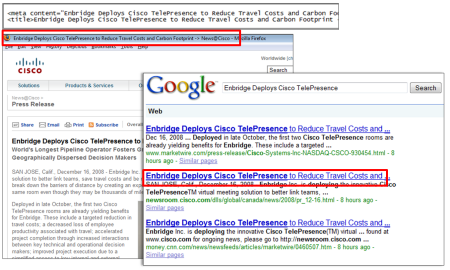 One of the most popular keyword optimization content types for SEOs and Public Relations professionals alike are press releases. As a news communication tool, the value of press releases has undergone changes. However, press releases provide a substantial amount of content to news search engines and can rank well in standard search engines like Google or Yahoo.
One of the most popular keyword optimization content types for SEOs and Public Relations professionals alike are press releases. As a news communication tool, the value of press releases has undergone changes. However, press releases provide a substantial amount of content to news search engines and can rank well in standard search engines like Google or Yahoo.
Multiple studies have documented that consumers and journalists are searching for and reading press releases. Optimizing press releases for a specific audience makes them easier to find and therefore, more of an asset for communicating news and attracting traffic to the company web site. As a result, it makes sense for marketing and PR practitioners alike to understand how to make press release content easier to find.
What Process Should You Follow to Optimize Press Releases? Here’s a useful checklist:
- Clearly define the goal and target audience of the release
- Research keyword phrases (1-2 per release)
- Add phrases to the title, sub heading and body copy
- Use keyword phrases when linking to landing pages or other corporate web site pages – not “click here”
- Add media to the release (images, video, audio) as well as alternative formats of the release (MS Word, PDF)
- To count conversions, use tracking codes in the URLs that point from the press release to landing pages
- Post the release to the company online newsroom
- Write a blog post version of the announcement and include a link to the press release
- Distribute the release via a wire service such as PRWeb, Marketwire, PRNewswire or Business Wire
- Optional: create and distribute a social media version of the press release
- Encourage bookmarking of press release pickups
- Monitor release rankings, social mentions, traffic & outcomes
The press releases that are hosted by the wire service offer a nominal amount of direct SEO value because they are new pages without link popularity. However, those releases are syndicated to other search channels like news search engines and can rank well there based on other factors like keyword placement within the release and the link popularity of the site that filters down to the release level.
 Press releases are often copied with links embedded into other news web sites and blogs as content and can result in direct traffic as well as links that are detected by search engines. Search engines count and value links as part of the ranking process. A single press release may result in 10 new inbound links or 1,000. It depends on the content and the reach. Compelling content typically attracts more links.
Press releases are often copied with links embedded into other news web sites and blogs as content and can result in direct traffic as well as links that are detected by search engines. Search engines count and value links as part of the ranking process. A single press release may result in 10 new inbound links or 1,000. It depends on the content and the reach. Compelling content typically attracts more links.
I cannot emphasize enough that it’s important that press releases are optimized for people first and search engines second. A highly ranked press release is of little value if it does not make sense to a person reading it. Few people will link to or pass along a press release that reads as if it were “optimized” for keyword phrases.
The single most important place to add keywords in a press release is in the title tag as shown in the image above. That same text is displayed at the top of the browser and is used as the hyperlinked title in the search results.
For more information on press release optimization, visit these previous posts:
- Press Release SEO Tips from PRNewswire, Business Wire, Marketwire & PRWeb
- Press Releases as Marketing Tools
- 4 Tips for Getting PR Approval on Optimized Press Releases
- Lowdown on Press Release Optimization
This is the 6th post in a series of ten on optimizing content for Public Relations. Be sure to visit us tomorrow for post #7 “Pull PR and Newsroom Optimization Tactics“.


